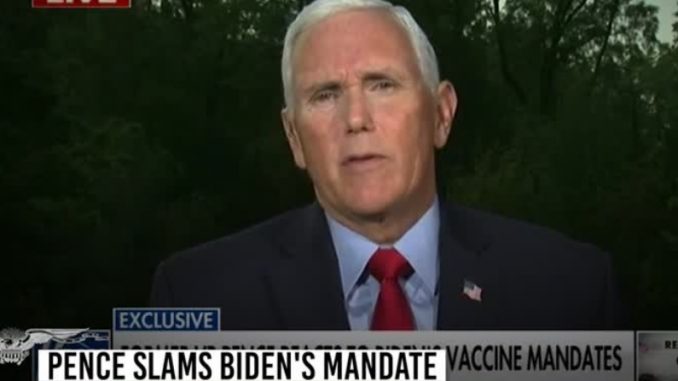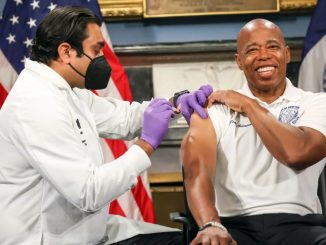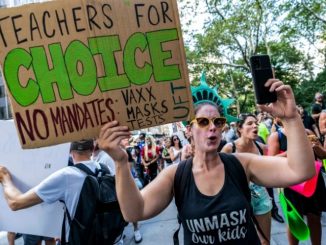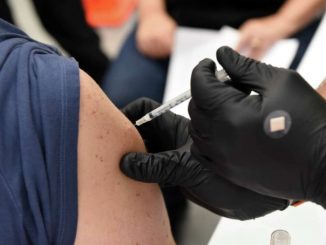
Workers should never be given a choice by their government of vaccination or termination.
The time has come for the Biden administration to follow the science.
November 27, 2022
One year ago, the Center for Medicare & Medicaid Services (CMS) issued an interim final rule requiring 15 types of health-care facilities that receive Medicare or Medicaid funding to ensure that their more than 10 million employees were vaccinated against Covid-19. This was one of multiple Biden administration mandates covering, in addition to medical workers, private employees at large firms (the OSHA mandate covering 84 million workers), federal contractors (one-fifth of the national workforce), 3.5 million federal employees, and Head Start employees, contractors, and volunteers. The administration designed these mandates to force American workers to choose between vaccination or their jobs. Federal courts have enjoined all of them except for the medical-worker one, which the Supreme Court allowed to continue. The administration withdrew the OSHA rule for private employees after the Court found that it exceeded OSHA’s statutory authority to address workplace hazards.
Now a coalition of 22 states, led by Montana attorney general Austin Knudsen, has made a convincing case for repealing the medical-worker vaccine mandate. The states, relying on a section of the Administrative Procedure Act that gives “an interested person the right to petition for the issuance, amendment, or repeal of a rule,” have filed a petition seeking repeal with the Department of Health and Human Services (HHS) and CMS (the part of HHS with primary responsibility for overseeing the Medicare program and the federal role in the Medicaid program).
Many of these states had previously challenged the rule as part of two separate lawsuits—one led by Missouri and the other by Louisiana. District courts in Missouri and Louisiana each found the rule defective and preliminarily enjoined enforcement. The government applied for an emergency stay of those injunctions, and the Supreme Court consolidated the two separate cases. A 5–4 Court majority concluded that the statute gave the HHS secretary authority “to promulgate, as a condition of a facility’s participation in the programs, such ‘requirements as [he] finds necessary in the interest of the health and safety of individuals who are furnished services in the institution.’” That authority would include measures to prevent transmission of communicable diseases and infections within those facilities.
The Court stayed the two district court injunctions, thereby allowing enforcement of the mandate while litigation to resolve the cases moved through the lower courts. That litigation continues in the district courts. In doing so, the Court relied on a finding by the HHS secretary that “a COVID–19 vaccine mandate will substantially reduce the likelihood that healthcare workers will contract the virus and transmit it to their patients.”
The new petition rehashes several legal arguments that, regardless of their merits, were made to and rejected by the narrow Supreme Court majority. But the petition is more effective in arguing that changed scientific circumstances undermine the HHS secretary’s justification that vaccinating staff protects patients. It claims that the medical evidence supporting the mandate was weak when the rule was issued and has become even less convincing as newer, more transmissible variants have become the predominant circulating viruses.
The rationale for imposing the mandate was that vaccines would protect medical workers from becoming infected and that, even if they were infected, vaccines would make them less likely to transmit the virus to residents and patients at medical facilities. But the initial vaccine trials were primarily focused on determining whether the vaccines protected against symptomatic Covid-19 infection, not against all transmission. They did not account for post-vaccination, mild, or asymptomatic infections, nor did they study secondary transmission.
In addition, the trials were conducted before the advent of newer, more transmissible viruses. By August 2021, nearly all U.S. cases were the newer Delta variant, which was associated with diminished effectiveness of vaccines against infection and illness, leading to increased numbers of breakthrough infections in fully vaccinated people and onward transmission to others.
Furthermore, it has long been apparent that protection against infection, regardless of the variant, wanes with time after vaccination. By six to 12 months post-vaccination, protection against infection is half or less of the protection in the first one to two months.
The Delta variant remained prevalent in November 2021 when CMS issued the vaccine mandate but was on the way to being supplanted by the far more transmissible Omicron and its subvariants. By December, Omicron was predominant and led to a rapid rise in daily case numbers in the U.S., even among the vaccinated. And the CDC had already acknowledged over the summer of 2021 that “[a]nyone with Omicron infection, regardless of vaccination status or whether or not they have symptoms, can spread the virus to others.”
By the time the Supreme Court issued its January 2022 decision allowing the vaccine mandate to be imposed, the vaccines had little or no effectiveness in limiting Covid infection and onward transmission.
The government does not dispute the vaccines’ waning effectiveness. In a September 2022 hearing before the full Fifth Circuit Court of Appeals (sitting en banc) that dealt with the federal employee mandate, the administration’s attorney said that when the mandate was issued last year, vaccines were thought to be effective against Covid-19 transmission and would protect employees from getting infected. “The fact is that the science has changed,” he conceded. “There are new variants and that particular rationale is somewhat eroded, but there are still significant rationales at play here in terms of preventing serious illness for federal employees, which has a clear nexus to the federal workplace in terms of productivity and efficiency.”
While protecting employees themselves from serious illness may or may not suffice for the purposes of a federal employee mandate (the Fifth Circuit has not ruled yet), it does not satisfy the statutory authority cited by the Supreme Court in upholding the medical-worker mandate to issue requirements “necessary in the interest of the health and safety of individuals who are furnished services in the institution.”
While I would hope that medical workers get vaccinated to protect themselves from serious Covid illness, it is now hard to justify forcing them to do so in the name of patient protection. More effective infection-control measures are now being utilized in medical facilities.
Continuing a vaccine mandate on pain of employment termination risks worsening nationwide medical staffing shortages. Hospital systems across the nation are experiencing shortages of physicians, nurses, technicians, respiratory therapists, and other hard-to-fill jobs. On average, 25 percent of the nation’s nursing homes report insufficient numbers of nurses and aides, and in many states the percentage is higher. Twenty-four states report that 30 percent or more of their facilities lack adequate staffing, and the top four states (Alaska, Minnesota, Maine, and Wyoming) exceed 60 percent.
Moreover, continuing a nationwide mandate ignores the fact that state and local governments—which historically and under the Constitution’s principles of federalism have been the locus of public health decision-making—are better able to assess local conditions and determine the most appropriate policies for limiting disease transmission in their facilities. Similarly, private institutions can and have imposed mitigation measures, including vaccine mandates, for their facilities when conditions warranted them.
The time has come for HHS and the Biden administration to follow the science and retract all vaccine mandates still being adjudicated in various federal courts. The federal government’s legal authority to impose any of them has always been dubious, and now there is no longer any scientific or medical justification for such autocratic and potentially counterproductive measures.
Joel Zinberg, M.D., J.D., is a senior fellow at the Competitive Enterprise Institute, an associate clinical professor of surgery at the Icahn Mount Sinai School of Medicine in New York, and the director of Paragon Health Institute’s Public Health and American Well-being Initiative. He was general counsel and senior economist in 2017–19 at the Council of Economic Advisers, where he specialized in health policy.
See also:
OSHA cannot constitutionally coerce people into vaccinations
Washington Examiner, by Devin Watkins
President Joe Biden says he will have federal regulators make employers require workers to get vaccinated against COVID-19, or else they’ll have to pay for continuous testing of the unvaccinated. That plan raises a serious constitutional problem: The federal government lacks the power to coerce people into vaccinations.
The Biden administration seems aware of this problem. For months, the White House has said it could not do this. As the White House chief of staff retweeted, “OSHA doing this vaxx mandate as an emergency workplace safety rule is the ultimate work-around for the Federal govt to require vaccinations.”
The basis for the new rule requiring vaccination or testing is that unvaccinated employees present a danger to other employees. To prevent that supposed “grave danger,” Biden plans to use the Occupational Safety and Health Administration to coerce businesses into doing so.
But the injection of a vaccine is far different than requiring a mask or a hard helmet. It’s a medical procedure. It involves a person having a substance injected into their body by a trained medical professional. All medical procedures and vaccines have risks. In fact, a database maintained by the government, the Vaccine Adverse Event Reporting System, lists hundreds of thousands of problems caused by vaccines. Many of these are rare, but they happen.
The Supreme Court held in the 1989 case Cruzan v. Director, Missouri Department of Health that “a competent person has a constitutionally protected liberty interest in refusing unwanted medical treatment.”
This right isn’t absolute. If there is a sufficiently compelling government interest, this constitutional right can be overcome. Protecting the health and safety of people due to a deadly pandemic would qualify.
The specific legal problem the Biden administration faces is that in America’s system of federalism and the power to protect the health and safety of the people, traditionally called the “police power,” was explicitly not given to the federal government. The police power was retained by the states. From the start of our republic, the states didn’t trust the federal government to make these decisions compared to state politicians who are more responsive to the local communities.
In fact, states likely have the power to do what the federal government proposes. For instance, in the 1905 case Jacobson v. Massachusetts, the Supreme Court upheld a state law requiring either vaccination or paying a small fine. People could still refuse to be vaccinated, but the state could impose a monetary incentive.
The decision in Jacobson was explicitly founded upon the police power and the fact this is a power only states have, not the federal government. The court wrote, “The authority of the State to enact this statute is to be referred to what is commonly called the police power — a power which the State did not surrender [to the federal government] when becoming a member of the Union under the Constitution.”
So, on the basis of Jacobson, while a state could pass a law requiring employers to require vaccination or weekly testing, the federal government lacks this power. In contrast, OHSA’s power to regulate workplaces is based on the Constitution’s Commerce Clause, not public health and safety.
The lack of federal power over vaccinations under the Commerce Clause came up in oral arguments at the Supreme Court in the 2012 Obamacare case. Justice Stephen Breyer asked attorney Michael Carvin if the federal government could require most people in the country to get vaccinated under the Commerce Clause.
Carvin responded, “No, they couldn’t do it because Morrison.”
In the 2000 case United States v. Morrison, the Supreme Court declared the Violence Against Women Act unconstitutional because the Commerce Clause only allows the federal government to regulate things that are economic in nature. While violence against women could obviously be regulated under states’ police power, the federal government lacked this power. The Commerce Clause could not be used to get around this requirement because violence against women, although it might affect commerce, was not economic in nature.
Similarly, coercing millions of people into undergoing a medical procedure they do not want, even for their own benefit, is not economic in nature and not within the power of the Commerce Clause.
I am fully vaccinated and encourage everyone to get vaccinated because the benefits outweigh the risks. But, however small those risks are, the risks do exist, and in America, people have a right to decide for themselves if they wish to take those risks and consent to the medical procedure. OSHA cannot legitimately coerce them into doing so.
Devin Watkins is an attorney with the Competitive Enterprise Institute, a free-market public policy organization based in Washington, D.C.
Richmond County Judge Ralph J. Porzio Ends the COVID Vaccine Mandate For All City Workers As “Unconstitutional, Arbitrary and Capricious”
Editor, Parentadvocates.org
Editor, New York Court Corruption
Editor, National Public Voice
Editor, NYC Public Voice
Editor, Inside 3020-a Teacher Trials




Be the first to comment